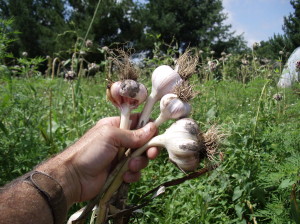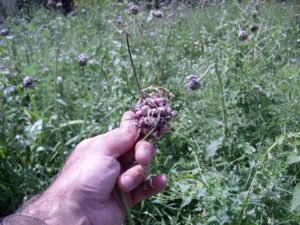In northern climates garlic is planted in late fall, a couple of weeks prior to the soil freezing. Some seed catalogs still sell garlic for spring planting, but if you live in a cool or cold climate, plant only in the fall to produce a quality crop.

Harvest mature garlic when the stem starts to dry. If you wait too long the stem decays and you have to dig up the garlic instead of pulling it.
Purchase garlic seed or bulbs that have been harvested this year for fall planting. Did you say seed? Yes! Garlic bulbs for planting sells between $4 and $20 a pound.
If you don’t mind waiting, seed (called bulbils) produced by hard-neck garlic can be grown out over two years to full-sized bulbs at a lower initial cost than using cloves from bulbs.
One type of garlic I have produces only about 5 big cloves per bulb, so I am putting 20% of my harvest back in the ground. However, the top of one garlic plant might produce over 50 seeds. Bulbils can be harvested when mature garlic is pulled from
the ground.
Garlic cloves and seed are planted and treated the same. In Wisconsin garlic is planted in late fall and harvested the following year near the end of July. You must harvest the seeded garlic at the same time as full grown bulbs. The seeded garlic will have only formed a small bulb or clove in one year. It goes back in the ground in late fall to be harvested the following July as full sized garlic.
Use this spring and summer to incorporate organic material into the area that you want to plant garlic. Garlic does best with high organic soils. Also set aside leaves in the fall to completely cover your planted garlic for the winter. Leave that mulch on for the growing season. Your garlic plants are very strong growers and will easily send a shoot through a 6 inch layer of loose leaf mulch in the spring.

